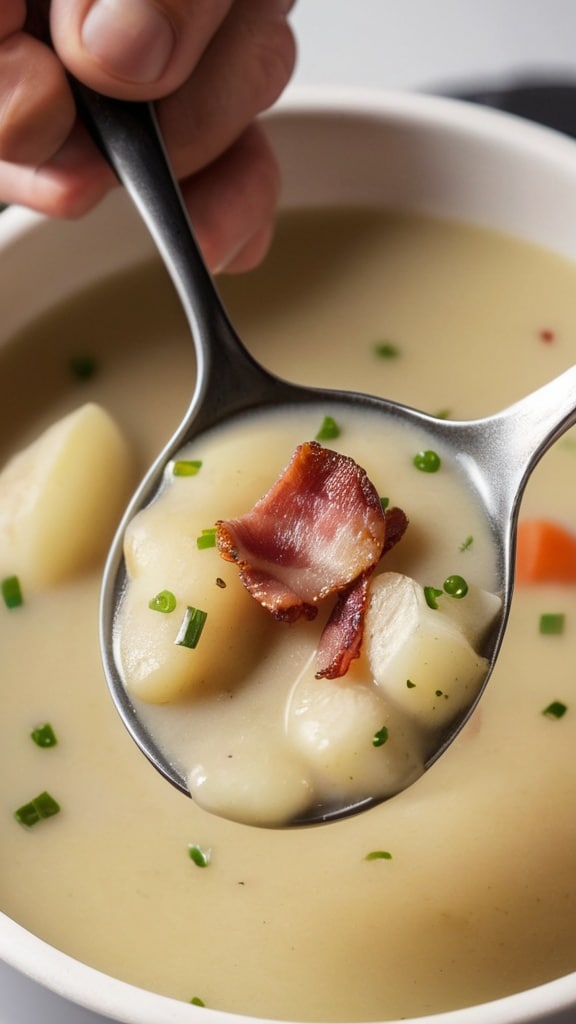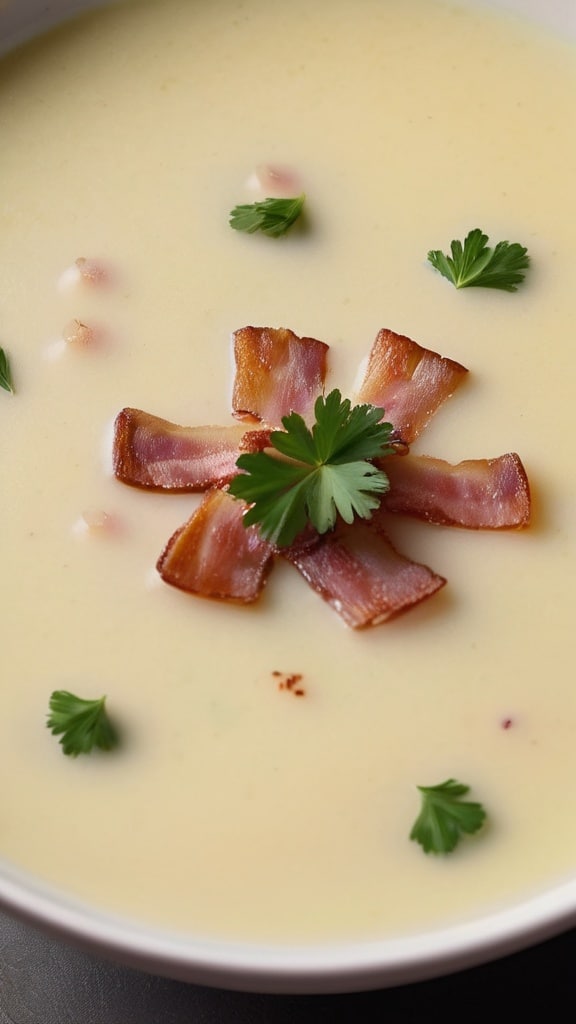The first time I tasted authentic Kartoffelsuppe in a small Bavarian gasthaus, I knew ordinary potato soup would never quite satisfy me again. Snow was falling outside, coating the medieval town in white, while inside, steam rose from a rustic ceramic bowl placed before me. That first spoonful velvety potatoes, smoky bacon, and aromatic leeks—transported me to a culinary tradition centuries in the making. German potato soup isn’t just food; it’s cultural heritage in liquid form.
Have you ever wondered why some potato soups taste transcendent while others fall flat? The secret often lies not in complexity but in technique and respect for ingredients. Kartoffelsuppe (literally “potato soup” in German) embodies the German cooking philosophy of making humble ingredients shine through careful preparation and balanced flavors.
1. Ingredients & Substitutions
Core Ingredients
- 2 pounds (about 1 kg) starchy potatoes (Russet or Yukon Gold)
- 4 ounces (115g) smoked bacon or speck, diced
- 2 medium leeks, white and light green parts only, cleaned and sliced
- 1 large yellow onion, finely diced
- 2 medium carrots, diced
- 1 stalk celery, diced
- 2 cloves garlic, minced
- 6 cups (1.5 liters) good-quality chicken or vegetable broth
- 1 bay leaf
- 1 teaspoon dried marjoram (traditional in German cooking)
- Salt and freshly ground black pepper
- 3 tablespoons fresh parsley, chopped
- 2 tablespoons unsalted butter
- Optional: 1/2 cup (120ml) heavy cream
Thoughtful Substitutions
For vegetarians, smoked tofu provides a surprisingly effective stand-in for bacon, capturing that essential smoky dimension without the meat. Its important to lightly fry it first to develop deeper flavor. Plant-based broths work beautifully, tho I recommend enhancing them with a teaspoon of miso paste for umami depth.
If leeks aren’t available, substitute with an additional onion plus two tablespoons of sliced green onions added at the end. Their not exactly the same, but they’ll provide that layered allium complexity typical of traditional Kartoffelsuppe.
Potatoes are the star here choosing the right variety matters tremendously. Starchy potatoes like Russets break down slightly during cooking, naturally thickening the soup without needing flour or cornstarch. Waxy potatoes maintain their shape but won’t create that luxurious texture. In Germany, you’d likely use Mehligkochende (floury) potatoes like Bintje or Agria.
2. Step-by-Step Instructions

Preparation
- Begin by preparing your mise en place. Peel and cut potatoes into 1/2-inch (1.3 cm) cubes, keeping them in cold water to prevent browning. Wash leeks thoroughly—they often harbor sand between their layers that can ruin your soup with unpleasant grittiness.
- In a large Dutch oven or heavy-bottomed pot, cook the diced bacon over medium heat until it renders its fat and becomes crisp, about 5-6 minutes. This step isn’t just about cooking the bacon; it’s about creating a flavorful fat base that will perfume the entire soup.
- Remove about 1/3 of the bacon bits with a slotted spoon and set aside for garnish. Don’t skip this step these crispy morsels will provide textural contrast to the finished soup.
Building Flavor
- Add the leeks, onion, carrots, and celery to the pot with the remaining bacon and bacon fat. Sauté until vegetables soften but don’t brown, about 7-8 minutes. Patience here pays dividends; rushing this step will result in underdeveloped flavor.
- Add the garlic and cook just until fragrant, about 30 seconds. A common mistake is adding garlic too early, which can lead to bitterness as it burns easily.
- Drain the potato cubes and add them to the pot, stirring to coat them in the flavorful fat. This brief sauté before adding liquid helps develop deeper potato flavor.
- Pour in the broth, add the bay leaf and marjoram, and bring to a gentle simmer. Avoid rapid boiling, which can break down the potatoes too quickly and create a gluey texture.
Finishing Touches
- Simmer uncovered for about 20 minutes, or until potatoes are tender when pierced with a fork. The broth should reduce slightly, concentrating flavors.
- For a partially smooth texture (traditional in many parts of Germany), use an immersion blender to briefly pulse the soup, leaving plenty of chunky bits intact. Alternately, remove about 2 cups of soup, blend until smooth, and return to the pot.
- Stir in the butter and optional cream. The butter adds a velvety mouthfeel that’s charateristic of proper German potato soup. Season generously with salt and freshly ground black pepper.
- Just before serving, stir in most of the fresh parsley, reserving some for garnish. The heat from the soup will release the herb’s volatile oils, amplifying its flavor.
For a heartier version, add sliced German sausages like Bockwurst or Frankfurters in the last 5 minutes of cooking. Many home cooks in northern Germany also add a touch of mustard to their bowls try it for a pleasant tangy counterpoint.
3. Cooking Techniques & Science
The deceptive simplicity of Kartoffelsuppe belies the careful technique required for excellence. When potatoes simmer in broth, they release starch molecules (primarily amylose and amylopectin) that thicken the liquid naturally. This is why vigorously stirring or over-blending can make potato soup gluey you’re essentially breaking down too many cell walls and releasing excessive starch.
The sequence of adding ingredients matters enormously. Building a flavor base with rendered bacon fat allows fat-soluble flavor compounds to develop fully before liquid is introduced. The aromatic vegetables (known as “Suppengrün” in German cooking) release water-soluble flavor compounds during the simmer phase, creating a balanced flavor profile impossible to achieve if all ingredients were added simultaneously.
Traditional German cooks often use a specialized tool called a Stampfer (potato masher) rather than a blender to achieve the perfect partially-smooth texture. The irregular consistency created by manual mashing actually creates more interesting mouthfeel than the uniform texture achieved by machine blending.
Some regional variations include adding a small amount of vinegar or sour cream just before serving. This culinary trick leverages acid to brighten flavors that have become muted during long cooking. The slight acidic note cuts through the richness, resetting the palate between spoonfuls.
Proper temperature control is essential throughout. The initial vegetable sauté should be low enough to soften without browning (the Maillard reaction would introduce unwanted flavors). The simmering phase should stay just below boiling to prevent potato disintegration.
4. Serving & Pairing Suggestions

In traditional German households, Kartoffelsuppe is often served as a complete meal, accompanied by crusty rye bread or Brötchen (small German rolls). The reserved crispy bacon bits should be sprinkled on top just before serving, along with the remaining fresh parsley.
For an authentic presentation, serve in pre-warmed, deep ceramic bowls—never flat soup plates, which would cool the soup too quickly. Some regions garnish with a small dollop of sour cream and a light dusting of paprika for color contrast.
Wine pairing deserves consideration. A dry German Riesling with good acidity cuts through the soup’s richness while complementing its subtle flavors. If you prefer beer, a malty German lager like a Munich Helles provides harmonious accompaniment without overwhelming the soup’s nuanced taste.
For a formal dinner, serve Kartoffelsuppe as a starter before Sauerbraten or Schnitzel. For a casual family meal, accompany with a simple green salad dressed with vinaigrette. The acidity of the salad provides pleasant contrast to the soup’s richness.
Regional variations offer fascinating serving alternatives. In parts of Swabia, they float small semolina dumplings (Griessnockerl) in the soup. In Berlin, you might find the soup garnished with Currywurst slices, merging two beloved German comfort foods.
Conclusion
Mastering Kartoffelsuppe reveals the sophistication behind Germany’s seemingly simple cuisine. Every element from potato selection to the patient building of flavors contributes to a final dish greater than the sum of its parts. While modern interpretations abound, the soul of this dish remains unchanged: transforming humble ingredients into something deeply satisfying through careful technique.
The true hallmark of successful German potato soup isn’t complexity but rather balance—the harmony between the earthiness of potatoes, the smoky depth of bacon, the sweetness of slowly cooked vegetables, and the bright finish of fresh herbs. This balance makes each spoonful both comforting and interesting.
Whether you’re seeking comfort on a cold day or looking to explore German culinary heritage, Kartoffelsuppe offers a delicious entry point. Make it once with care, and you’ll understand why generations of German cooks have treasured this recipe as essential culinary knowledge worth preserving and passing down.
FAQs
Why does my potato soup sometimes turn gluey?
Overmixing or overblending releases too much starch from the potatoes. For ideal texture, blend only briefly or mash by hand, and avoid vigorous stirring once the potatoes have softened. Also, starchy potatoes like Russets are more prone to this issue than waxy varieties, so adjust your technique accordingly.
Can I make German potato soup ahead of time?
Absolutely! Like many soups, Kartoffelsuppe often tastes better the second day as flavors meld. However, if using cream, add it only when reheating to prevent potential curdling during storage. Reheat gently, stirring occasionally to prevent scorching.
Is traditional German potato soup gluten-free?
Yes, authentic Kartoffelsuppe contains no flour or other gluten-containing ingredients for thickening. The natural starch from potatoes provides all the necessary body. However, always check your broth ingredients if using store-bought, as some may contain trace gluten.
What’s the difference between German potato soup and other European versions?
German potato soup distinguishes itself through the use of leeks, the inclusion of smoked meat (typically bacon or speck), and the specific herb profile featuring marjoram. French potato soup often includes more cream, while Eastern European versions might incorporate paprika or other distinctive spices.
How do I adjust the consistency if my soup is too thick or thin?
If too thick, thin with additional broth or a splash of cream. If too thin, remove some liquid and continue simmering uncovered, or take a cup of soup, blend thoroughly, and return to the pot to thicken naturally without adding flour or cornstarch, which would be inauthentic.

